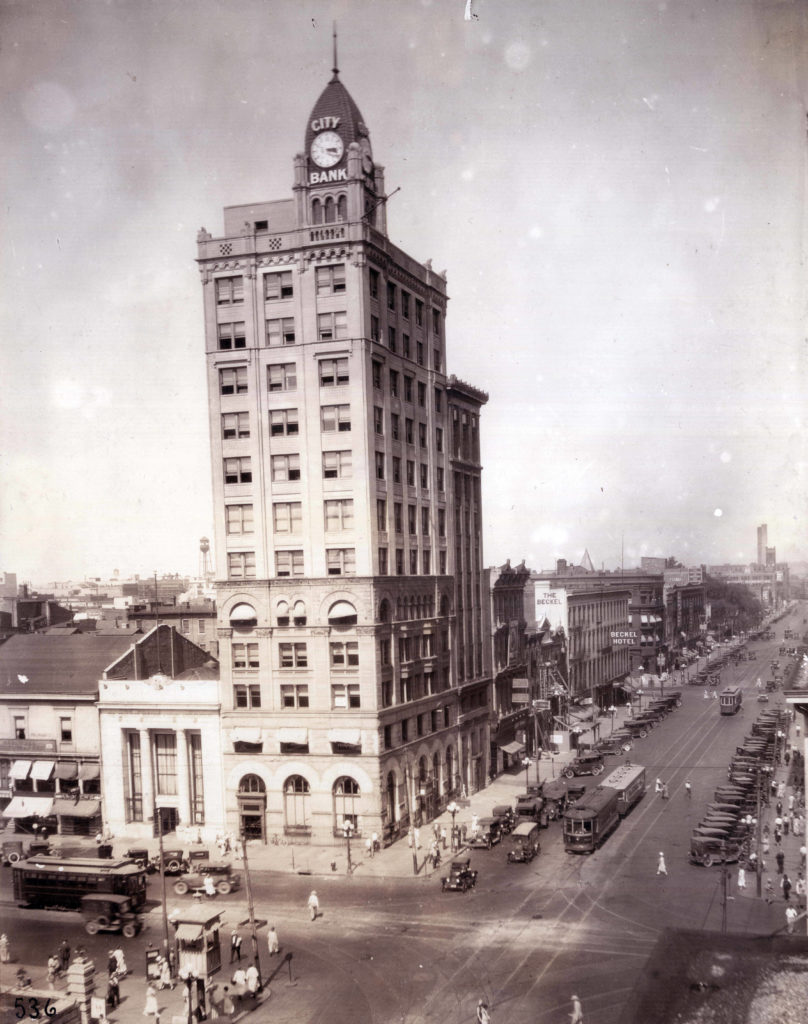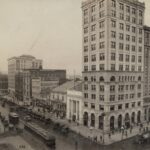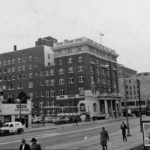
The Callahan Building is considered by many to be Dayton’s first skyscraper. Originally a 7-story building, it was built at the NE corner of Main and Third, right across Main Street from the Old Courthouse, in 1892.
 One notable Daytonian connected with this building is Paul Laurence Dunbar (right), who worked as an elevator operator in the Callahan when he was just starting to work on his first volume of poems.
One notable Daytonian connected with this building is Paul Laurence Dunbar (right), who worked as an elevator operator in the Callahan when he was just starting to work on his first volume of poems.
According to critics, his exposure to a variety of accents and dialects in a bustling downtown Dayton had a significant effect on his development as a writer. (The Dunbar House is today a museum on the near west side of Dayton.)
The United Brethren Publishing House, just a block South in what today is known as the Centre City Building, actually published Dunbar’s first collection Oak & Ivy. And Dunbar reportedly made a decent number of sales to his elevator passengers while working at the Callahan.
The Callahan Building was the longtime home of City National Bank, and its clock soon became a major symbol associated with downtown Dayton.
The building went through a major remodel in 1920 when the top floors were taken out and seven new floors were built to be topped by a new clock tower (see below).
In the following years the clock was known by many as the Gem City Clock and it “served as a beacon for travelers navigating to the center of the city at night.”

The Clock That Outlived Its Building
The Callahan Building was demolished in 1978, but the clock, still a beloved downtown symbol, was saved and moved to a Reynolds & Reynolds building on Germantown Street.
That building too was slated to be demolished in 2006, and there was again uncertainly as to what would happen to the clock. Eventually it was moved to Carillon Park, where it was for several years located on the ground.
But in 2019 it was once again placed high in the air on a new 100 foot Brethen Tower that was part of a major park renovation. Visitors can climb the 120 steps to the top of the tower to see not only the clock but sweeping views of the Great Miami River, the University of Dayton, and downtown Dayton and its surroundings.
Back at the corner of Third and Main downtown, the I.M. Pei designed Gem City Plaza/National City Center (until recently the home of PNC Bank and now the site of the Dayton Chamber of Commerce) now occupies the corner where the Callahan once stood. With Courthouse Square across the street instead of the new Courthouse building that was also demolished in the 1970s, the scene looks much different than the days of the Callahan Building.
For more on the history of the Callahan Building, as well as other early skyscrapers like the Centre City and the Reibold Building, check out my book Lost Dayton, Ohio.
Callahan Building images are courtesy of Dayton Metro Library




It was really interesting to read about how the clock tower acted as a beacon for people who were traveling during the night. In my opinion, it is important to preserve clock towers because they represent an age of development in our history. I think it is important for us to preserve and restore clock towers so that they can last for a long time.
The clock chimed using the westminster chime mehod. Were there bells located with the clock or was it a tecording eith anamplifier and dpeakers? How did it do thewestminster chime?
i am still wondering how the clock chimed.